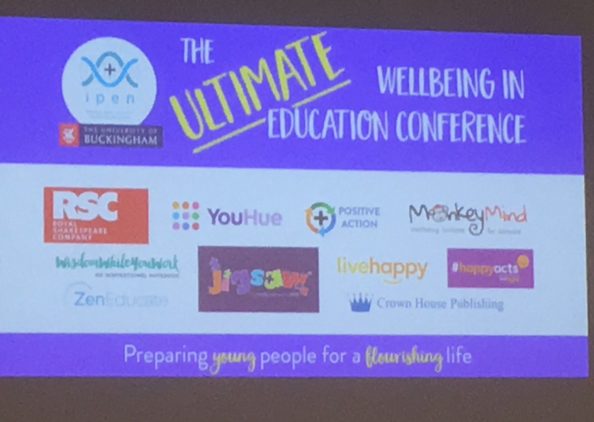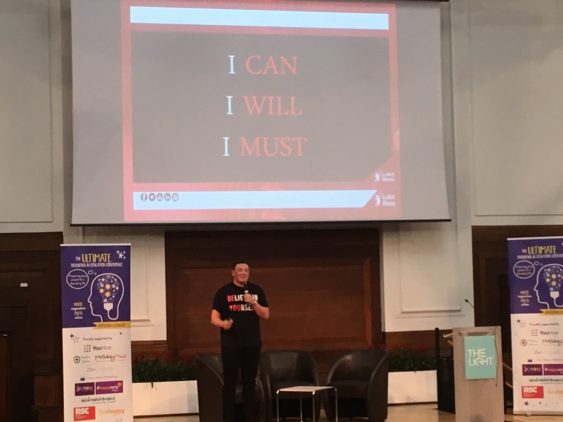On Friday 19 October Big Change attended the Ultimate Wellbeing in Education Conference – A full day of insights into wellness and mental health for young people, in the education sector, and ultimately for everyone.
It was apparent even from the first five minutes of the event that this was set to be one of utter inspiration, and tangible change-making knowledge and skills.
The conference was hosted by Vice-Chancellor of The University of Buckingham and Founder of Action for Happiness, Sir Anthony Seldon, who opened the conference with these sentiments:
“We can all transform our worlds”, “You can be the difference” and “It’s not me, it’s us.”

What followed throughout the day was an incredible group of speakers sharing stories of mental health and wellbeing, and research into and practical initiatives building wellbeing with young people and in schools.
Here are just some of the most memorable moments from the conference…
How are you?
Ammar Khan is co-founder and CEO of the app YouHue, which uses mood tracking to empower students to understand their emotions so they can better manage and communicate them. Khan asked the audience to consider that although there is growing recognition of the important of us as adults checking in with ourselves, ‘How often do we give students the opportunity to examine their feelings?’
Laugh while you Learn
Stephanie Davies’s story really resonated with our Big Change focus on school exclusions. Expelled from school twice and told she wouldn’t build a successful career, Stephanie went on to become a stand-up comedian before transitioning into psychology. She’s focused on the use of humour in learning – particularly in memory recall, saying that laughter not only helps us feel better it also helps us learn better.
Stephanie had the whole auditorium on their feet and in laughter participating in her exercise where we recalled 10 random things with 10 random associations. She first asked the audience to call out 10 things at random and then she assigned each one to a part of the body such as head or elbow. Next, selected audience members were asked to say ‘Why is there an elephant in your eye?’, ‘why would a dog be sitting on your head?’, and at the end we could all recall where and what each item was no matter the order.
The 11 per cent
Richard Crellin from The Children’s Society presented key findings from The Good Childhood Report 2018 delving into the inequality in wellbeing in young people.
Crellin stressed that not only is it imperative that we take the time to ask young people how they are but that we are prepared to respond to their answers.
If we commit to asking young people these types of questions, which can be difficult for them to access on an emotional level then we must be ready to offer any help that is called for.
He said also that it’s important to note the positive fact that 89% of young people in the survey have high wellbeing. However, in order to achieve true wellness for all it’s vital to respond to the 11% who report low wellbeing, as this is a consistent figure that fails to change year-on-year.
A Resilient Mindset
Bounce Forward (previously known as How to Thrive) is a Big Change project partner so it was fantastic to hear from CEO Lucy Bailey talking about the difference they have made in teaching young people resilience practices.
Bounce Forward apply research on resilience into schools to make tangible difference. They teach the idea that we don’t need to be perfect as long as we ‘have a go’.
This project has now trained almost 10K adults through a five-day training scheme, 600 schools and touched the lives of half a million young people in the UK.
Against all Odds
Luke Rees is a Step up to Serve #IWill ambassador and courageously spoke about his own mental health story. He told of a journey that we all likely recognise – the person with depression and anxiety who puts on the mask of the joker, the social butterfly and bottles up feelings for too long, before speaking out.

Because of his struggles Luke left school with four GCSEs but was determined to go to University despite the words of doubt he came up against. It was truly inspiring to see him finish with a photograph of his graduation!
He said “Change starts with you”, and “I never lose, I either win or I learn.”
Positive Psychology
The conference’s key speaker was Professor Martin Seligman from the University of Pennsylvania.
Seligman sees wellbeing as made up by two elements: the reduction of the negative and the building up of the positive. One without the other cannot achieve positive wellbeing.
One research finding that really stuck from Seligman’s various research projects: Pessimism is the biggest factor in cardio vascular disease – higher than any of the traditional risk factors such as obesity.
In fact, according to Seligman, being a pessimist is like smoking a pack and half a day in terms of your heart health. He says positive people live on average seven years longer – this compared to three years longer for people who regularly exercise, and six years longer for non-smokers.
Fortunately, Seligman says his research shows that we can learn and teach optimism. His team have taken this into schools.
Seligman defines pessimism by the finding of a permanent and helpless explanation for a situation, whereas optimism sees a temporary and changeable explanation.
In terms of fostering this in young children he uses the example of a young girl who sees her best friends sit at a different table during lunch. A pessimistic reaction sees the child imagining that she is not liked.
However, teaching a child to consider the situation in temporary terms such as the realisation that her friends are all on a sports team that she is not part of and are sitting at another table to have a team meeting – this scenario has nothing to do with the dynamics of the friendship and allows the child to move on without negative feelings.
Seligman then expanded on his theory of positive psychology using the acronym PERMA:
P – pleasant emotions
E – engagement
R – relationships
M – meaning and purpose
A – achievement
What’s the easiest way to attain PERMA? Seligman says write down three things that went well at the end of each day and why. It’s the practice of gratitude, which he has proven in research makes a significant difference to a person’s wellbeing.
Seligman says that schools should value wellbeing in students. He says a teacher’s job is to increase PERMA for their students as well as teaching academics. The exact ‘how’ for a teacher to do this though is down to them, because he says it is our teachers not the administration who know their students and what will work best for them. And, he says schools need to reward teachers who are successful in raising PERMA.
What’s Shakespeare got to do with it?
Jacqui O’Hanlon, Education Direction at the Royal Shakespeare Company – members of which delighted us with moving monologues throughout the day – reiterated what we know about early years development.
O’Hanlon said that “the language development a child has by the age of five is still the greatest predictor of whether that child will experience poverty.”
Big Change is focusing on the first five years by backing projects that increase engagement during this time through play at home so that children are more equipped for entering school.
Just as we all have physical health, so we all have mental health and wellbeing. Huge areas in their own right, these run through all the issues that we tackle for young people at Big Change. The Ultimate Wellbeing in Education Conference mirrored our belief that we need to focus on the whole child so they thrive in life, not just in exams.
